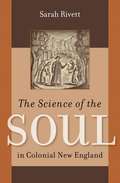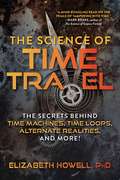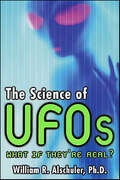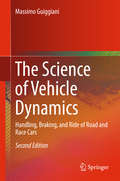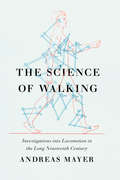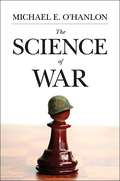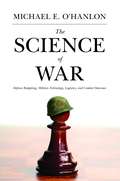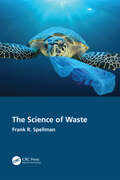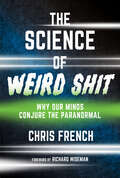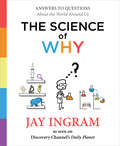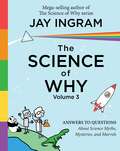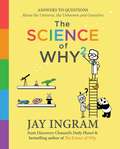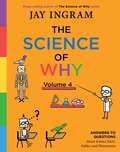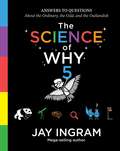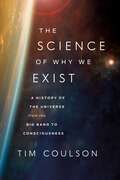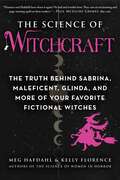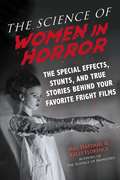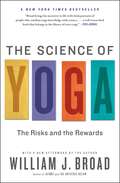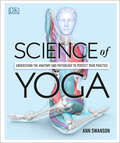- Table View
- List View
Science of the Physical Creation in Christian Perspective (2nd Edition)
by Dewitt Steele Gregory ParkerTopics covered in this text book include atmosphere, weather, seas, molecules, weathering , erosion , waves , sound, light , color and many more.
The Science of the Soul in Colonial New England
by Sarah RivettThe Science of the Soul challenges long-standing notions of Puritan provincialism as antithetical to the Enlightenment. Sarah Rivett demonstrates that, instead, empiricism and natural philosophy combined with Puritanism to transform the scope of religious activity in colonial New England from the 1630s to the Great Awakening of the 1740s.In an unprecedented move, Puritan ministers from Thomas Shepard and John Eliot to Cotton Mather and Jonathan Edwards studied the human soul using the same systematic methods that philosophers applied to the study of nature. In particular, they considered the testimonies of tortured adolescent girls at the center of the Salem witch trials, Native American converts, and dying women as a source of material insight into the divine. Conversions and deathbed speeches were thus scrutinized for evidence of grace in a way that bridged the material and the spiritual, the visible and the invisible, the worldly and the divine.In this way, the "science of the soul" was as much a part of seventeenth- and eighteenth-century natural philosophy as it was part of post-Reformation theology. Rivett's account restores the unity of religion and science in the early modern world and highlights the role and importance of both to transatlantic circuits of knowledge formation.
The Science of Time Travel: The Secrets Behind Time Machines, Time Loops, Alternate Realities, and More!
by Elizabeth HowellTravel back in time with Doctor Who, the Terminator, the X-Men, and all your favorite time travelers! Science fiction is the perfect window into the possibilities and perils of time travel. What would happen if you went back in time and killed your own grandparent? If you knew how to stop a presidential assassination, would time travel allow you to make your wish come true? Can we use time travel as a tool to escape the destiny of our future or mistakes of the past? The Science of Time Travel explores time travel through your favorite science-fiction franchises, from the classic time travel paradoxes of Star Trek to the universe-crossing shenanigans of Doctor Who. Discover the real science behind questions such as: Can time travel really erase our past regrets like in A Christmas Carol?Is it worth killing people in the past to prevent a horrible future like in Terminator?What can we learn from living the same day over and over again like in Groundhog Day?Could time travel destroy our right to privacy like in Deja Vu?And so much more! It's time to fire up the DeLorean to 88 mph, jump into the TARDIS hiding in plain sight, or warp space with the USS Enterprise to explore what time travel means for us.
The Science of UFOs
by William R. AlschulerWhat if UFOs are real?Where could they be from, and how could they have traveled here? What advanced technology must they possess to execute the fantastic maneuvers they are routinely reported to make?Astronomer William R. Alshuler takes a fascinating look at the reported attributes of UFOs through the lens of known science and physics and explains how they might be doing the weird and incredible things they are known to do.Along the way, he examines the possibilities and problems of traveling faster than light, interdimensionally, and via teleportation, as well as the veracity of UFO reports, insights into potential alien motives, and alien biochemistry.
The Science of Vehicle Dynamics: Handling, Braking, And Ride Of Road And Race Cars
by Massimo GuiggianiThis textbook covers handling and performance of both road and race cars. Mathematical models of vehicles are developed always paying attention to state the relevant assumptions and to provide explanations for each step. This innovative approach provides a deep, yet simple, analysis of the dynamics of vehicles. The reader will soon achieve a clear understanding of the subject, which will be of great help both in dealing with the challenges of designing and testing new vehicles and in tackling new research topics.The book deals with several relevant topics in vehicle dynamics that are not discussed elsewhere and this new edition includes thoroughly revised chapters, with new developments, and many worked exercises.Praise for the previous edition:Great book! It has changed drastically our approach on many topics. We are now using part of its theory on a daily basis to constantly improve ride and handling performances. --- Antonino Pizzuto, Head of Chassis Development Group at Hyundai Motor Europe Technical CenterAstonishingly good! Everything is described in a very compelling and complete way. Some parts use a different approach than other books.--- Andrea Quintarelli, Automotive Engineer
The Science of Walking: Investigations into Locomotion in the Long Nineteenth Century
by Andreas MayerThe Science of Walking recounts the story of the growing interest and investment of Western scholars, physicians, and writers in the scientific study of an activity that seems utterly trivial in its everyday performance yet essential to our human nature: walking. Most people see walking as a natural and unremarkable activity of daily life, yet the mechanism has long puzzled scientists and doctors, who considered it an elusive, recalcitrant, and even mysterious act. In The Science of Walking, Andreas Mayer provides a history of investigations of the human gait that emerged at the intersection of a variety of disciplines, including physiology, neurology, orthopedic surgery, anthropology, and psychiatry. Looking back at more than a century of locomotion research, Mayer charts, for the first time, the rise of scientific endeavors to control and codify locomotion and analyzes their social, political, and aesthetic ramifications throughout the long nineteenth century. In an engaging narrative that weaves together science and history, Mayer sets the work of the most important representatives of the physiology of locomotion—including Wilhelm and Eduard Weber and Étienne-Jules Marey—in their proper medical, political, and artistic contexts. In tracing the effects of locomotion studies across other cultural domains, Mayer reframes the history of the science of walking and gives us a deeper understanding of human movement.
The Science of Walking: Investigations into Locomotion in the Long Nineteenth Century
by Andreas MayerThe Science of Walking recounts the story of the growing interest and investment of Western scholars, physicians, and writers in the scientific study of an activity that seems utterly trivial in its everyday performance yet essential to our human nature: walking. Most people see walking as a natural and unremarkable activity of daily life, yet the mechanism has long puzzled scientists and doctors, who considered it an elusive, recalcitrant, and even mysterious act. In The Science of Walking, Andreas Mayer provides a history of investigations of the human gait that emerged at the intersection of a variety of disciplines, including physiology, neurology, orthopedic surgery, anthropology, and psychiatry. Looking back at more than a century of locomotion research, Mayer charts, for the first time, the rise of scientific endeavors to control and codify locomotion and analyzes their social, political, and aesthetic ramifications throughout the long nineteenth century. In an engaging narrative that weaves together science and history, Mayer sets the work of the most important representatives of the physiology of locomotion—including Wilhelm and Eduard Weber and Étienne-Jules Marey—in their proper medical, political, and artistic contexts. In tracing the effects of locomotion studies across other cultural domains, Mayer reframes the history of the science of walking and gives us a deeper understanding of human movement.
The Science of War: Defense Budgeting, Military Technology, Logistics, and Combat Outcomes
by Michael E. O’hanlonThe U.S. military is one of the largest and most complex organizations in the world. How it spends its money, chooses tactics, and allocates its resources have enormous implications for national defense and the economy. The Science of War is the only comprehensive textbook on how to analyze and understand these and other essential problems in modern defense policy. Michael O'Hanlon provides undergraduate and graduate students with an accessible yet rigorous introduction to the subject. Drawing on a broad range of sources and his own considerable expertise as a defense analyst and teacher, he describes the analytic techniques the military uses in every crucial area of military science. O'Hanlon explains how the military budget works, how the military assesses and deploys new technology, develops strategy and fights wars, handles the logistics of stationing and moving troops and equipment around the world, and models and evaluates battlefield outcomes. His modeling techniques have been tested in Iraq and Afghanistan, including the methods he used to predict higher-than-anticipated troop fatalities in Iraq--controversial predictions that have since been vindicated. The Science of War is the definitive resource on warfare in the twenty-first century. * Gives the best introduction to defense analysis available * Covers defense budgeting * Shows how to model and predict outcomes in war * Explains military logistics, including overseas basing * Examines key issues in military technology, including missile defense, space warfare, and nuclear-weapons testing * Based on the author's graduate-level courses at Princeton, Columbia, and Georgetown universities
The Science of War: Defense Budgeting, Military Technology, Logistics, and Combat Outcomes
by Michael E. O'HanlonAn essential introduction to modern defense policyThe U.S. military is one of the largest and most complex organizations in the world. How it spends its money, chooses tactics, and allocates its resources have enormous implications for national defense and the economy. The Science of War is the only comprehensive textbook on how to analyze and understand these and other essential problems in modern defense policy.Michael O'Hanlon provides undergraduate and graduate students with an accessible yet rigorous introduction to the subject. Drawing on a broad range of sources and his own considerable expertise as a defense analyst and teacher, he describes the analytic techniques the military uses in every crucial area of military science. O'Hanlon explains how the military budget works, how the military assesses and deploys new technology, develops strategy and fights wars, handles the logistics of stationing and moving troops and equipment around the world, and models and evaluates battlefield outcomes. His modeling techniques have been tested in Iraq and Afghanistan, including the methods he used to predict higher-than-anticipated troop fatalities in Iraq—controversial predictions that have since been vindicated.The Science of War is the definitive resource on warfare in the twenty-first century.Gives the best introduction to defense analysis availableCovers defense budgetingShows how to model and predict outcomes in warExplains military logistics, including overseas basingExamines key issues in military technology, including missile defense, space warfare, and nuclear-weapons testingBased on the author's graduate-level courses at Princeton, Columbia, and Georgetown universities
The Science of Waste
by Frank R. SpellmanWaste can be defined as something no longer wanted, something destroyed, broken, or damaged beyond repair and therefore disposed of or simply thrown away because it is no longer functional, needed, or wanted. However, the focus of this book turns to the question: is waste always really a waste? Stated differently, waste is not a waste if it can be recycled in some form or the other. This book examines all types of waste and their impacts, and discusses the potential ways to mitigate them through recycling and reuse strategies. Features: Addresses agricultural, biomedical, chemical, construction, hazardous, human, municipal solid waste, and more. Explains the fundamentals for waste recycling and reuse. Examines the current state of ocean pollution as well as the latest international regulations. Covers the life cycles of consumer electronic products, and their related metals and minerals, which are increasingly a major source of "E-Waste" The Science of Waste is intended to be used by environmental scientists and engineers, public health officials, legal professionals, students, and instructors interested in waste, as well as the management and reuse thereof.
The Science of Weird Shit: Why Our Minds Conjure the Paranormal
by Chris FrenchAn accessible and gratifying introduction to the world of paranormal beliefs and bizarre experiences.Ghostly encounters, alien abduction, reincarnation, talking to the dead, UFO sightings, inexplicable coincidences, out-of-body and near-death experiences. Are these legitimate phenomena? If not, then how should we go about understanding them? In this fascinating book, Chris French investigates paranormal claims to discover what lurks behind this &“weird shit.&” French provides authoritative evidence-based explanations for a wide range of superficially mysterious phenomena, and then goes further to draw out lessons with wider applications to many other aspects of modern society where critical thinking is urgently needed.Using academic, comprehensive, logical, and, at times, mathematical approaches, The Science of Weird Shit convincingly debunks ESP, communicating with the dead, and alien abduction claims, among other phenomena. All the while, however, French maintains that our belief in such phenomena is neither ridiculous nor trivial; if anything, such claims can tell us a great deal about the human mind if we pay them the attention they are due. Filled with light-bulb moments and a healthy dose of levity, The Science of Weird Shit is a clever, memorable, and gratifying read you won&’t soon forget.
The Science of Why: Answers to Questions About the World Around Us
by Jay IngramEver wonder why onions make you cry? Or why lizards do pushups? Or why leaves change color in the fall?Don't worry, you're not alone. Acclaimed science writer and broadcaster Jay Ingram wonders the same things. After a long career of asking important questions (Does time speed up as we age? How much Neanderthal is in me? Why do some animals throw their feces?), he's here to put our scientific quandaries to rest. In this insightful, witty book for curious readers of all ages, Jay shares his favorite head-scratchers and mind-benders, settling pressing questions, such as... -What is déjà vu? -Why were Tyrannosaurus Rex's arms so short? -Why are you plagued by mosquitoes while your friends aren't? -Does your cat actually like you?* -What is déjà vu? ...along with everything you ever wondered about human echolocation, Bigfoot and farts (though not all at once). Whimsically illustrated and chock-full of fun science facts (and fictions), this book will delight and surprise your inner science geek. *SPOILER: She actually thinks you're a larger, dumber version of her mother.
The Science of Why: Answers to Questions About Science Myths, Mysteries, and Marvels
by Jay IngramThe newest volume in the beloved Science of Why series—full of fascinating science that will amuse and astonish readers of all ages.Have you wondered why you cringe when fingernails are scratched along a chalkboard? Or whether you could ever have a cybernetic limb? Or if a shark can smell a drop of blood a mile away? Then you’re in luck! Bestselling author Jay Ingram is back to answer all those questions and more as he explores and explains the world around us in all of its head-scratching curiosity. From the smallest parts inside us to the biggest questions about our universe, Jay tackles pressing topics, such as: Could we use a laser to shoot an asteroid that was about to hit earth? What exactly was a dodo and why did it go extinct? Why do beans make me fart? Touching on everything from food to robots to space to the animal kingdom, The Science of Why 3 is perfect for anyone who has stayed up late into the night pondering the weird and wonderful world we live in. Full of captivating science questions (and answers!), this book is sure to surprise and delight science readers of all ages.
The Science of Why 2: Answers to Questions About the Universe, the Unknown, and Ourselves
by Jay IngramAn all-new volume of science questions to delight, entertain, and inform readers of all ages, from bestselling author Jay Ingram.Bestselling author and commentator Jay Ingram is back to explain the magic and mysteries of the world around us. Jay takes readers on a tour of the universe, exploring wonders big and small. From the farthest reaches of space to the most perplexing historical riddles to the marvels of who we are and what we’re made of, Jay answers the important questions, such as: What’s inside a black hole? Will machines ever learn to feel? How much pee is in the average swimming pool? Because who hasn’t wondered whether we’re living in a computer simulation? Or whether Atlantis existed? Or why cats always land on their feet? With wit, wisdom, and whimsical illustrations, The Science of Why 2 will delight readers of all ages with the answers to all these questions and more. Full of fun science facts (and fictions), this is the book that everyone’s inner science geek needs to read.
The Science of Why, Volume 4: Answers to Questions About Science Facts, Fables, and Phenomena (The Science of Why series #4)
by Jay IngramBack by popular demand: a brand-new volume of science queries, quirks, and quandaries in the mega-bestselling Science of Why series, sure to enlighten and entertain readers of all ages.Have you ever wondered why we close our eyes when we sneeze? Or how far underground things can live? Or if there&’s a way to choose the fastest lineup at the grocery store? Yes? Then fasten your seat belts! Bestselling author Jay Ingram is here to take you on a rollercoaster ride through science&’s most perplexing puzzles. From the age-old mysteries that have fascinated us to the pressing unknowns about our future and all the everyday wonderings in-between, Jay answers questions that confound and dumbfound, such as: Why do zebras have stripes? How many universes might there be? Can we live for 200 years? ...along with everything you ever wanted to know about alien civilizations, photographic memories, nanobots, poop, and (conveniently) toilet paper. Bursting with laugh-out-loud illustrations, jaw-dropping marvels, and head-scratching science fictions, The Science of Why, Volume 4 will give readers of all stripes a real thrill.
The Science of Why, Volume 5: Answers to Questions About the Ordinary, the Odd, and the Outlandish (The Science of Why series #5)
by Jay IngramChock-full of peculiar puzzles, mind-bending mythbusters, and quirky questions, the fifth pop science book in the bestselling Science of Why series is perfect for anyone curious about the weird and wondrous world we live in.Have you ever wondered if octopuses are from outer space? What Mexican jumping beans are? Or if banana peels are really slippery? If questions like these are keeping you up at night, you can rest easy. Bestselling author Jay Ingram is here to answer all the whimsical and whacky wonderings that have baffled people since the dawn of time. From our bodies to our pets (and other beasts) to the natural world around us, Jay tackles science topics big and small, such as: Did dinosaurs sit on their eggs? What is our funny bone? Is there a specific muscle that makes dogs cute? Because who hasn&’t pondered whether plants have feelings? Or if Robin Hood was a real person? Or what humans will look like in the future? Teeming with amusing answers to bemusing questions—and handy and hilarious illustrations—this latest volume separates fact from fiction, lesson from legend, and myth from marvel. Endlessly illuminating and entertaining, The Science of Why, Volume 5 is five times the fun for new and old readers of the series.
The Science of Why We Exist: A History of the Universe from the Big Bang to Consciousness
by Tim CoulsonFrom the Big Bang and the evolution of the genetic code to the birth of consciousness, this is the extraordinary story of the chain of events that led to human life on earth.Have you ever wondered why you exist? What had to happen for you to be alive and conscious? Scientists have come a long way in answering this question, and this book describes what they have found out. It also examines whether our existence was inevitable at the universe&’s birth 13.77 billion years ago—or whether we are just incredibly lucky. The book is aimed at readers who are interested in science but are not experts. Written in an entertaining and accessible style, the narrative begins by describing how scientists discover facts before taking the reader on a journey from the Big Bang to the creation of the human genome. Covering physics, astronomy, chemistry, earth sciences, the emergence of life, evolution, consciousness, the rise of humanity, and how our personalities are moulded by genes, chance, and the environment, the journey explains how the universe started as point of intense energy that over time, in our corner of the universe, resulted in our wonderful planet—and in you.
The Science of Witchcraft: The Truth Behind Sabrina, Maleficent, Glinda, and More of Your Favorite Fictional Witches (The Science of)
by Meg Hafdahl Kelly FlorenceA scientific discovery of witches in fiction—Chilled Adventures of Sabrina, Sleeping Beauty, Wicked and so many more! Kelly Florence and Meg Hafdahl, authors of The Science of Women in Horror and co-hosts of the Horror Rewind podcast called &“the best horror film podcast out there&” by Film Daddy, present a guide to the history of witchcraft through the stories and characters we all know and love. Reveal the spellbinding science behind the legends and lore surrounding fiction&’s most iconic witches, answering such questions as: What is the science behind divination and spellcraft?When did witchcraft begin to show up in literature and media?Has science made it possible to uncover the truth behind the powers of necromancy and employing familiars?How has witchcraft been thought of throughout the world? Through interviews, film and literary analysis, and bone-chilling discoveries, join Kelly and Meg as they learn about the complicated and rich science of witchcraft throughout the centuries and discover why now is the season of the witch!
The Science of Women in Horror: The Special Effects, Stunts, and True Stories Behind Your Favorite Fright Films
by Meg Hafdahl Kelly FlorenceFrom scream queens to femmes fatale, horror isn&’t just for the boys. Gothic media moguls Meg Hafdahl and Kelly Florence, authors of The Science of Monsters, and co-hosts of the Horror Rewind podcast called &“the best horror film podcast out there&” by Film Daddy, present a guide to the feminist horror movies, TV shows, and characters we all know and love. Through interviews, film analysis, and bone-chilling discoveries, The Science of Women in Horror uncovers the theories behind women&’s most iconic roles of the genre. Explore age-old tropes such as &“The Innocent&” like Lydia in Beetlejuice, &“The Gorgon&” like Pamela Voorhees in Friday the 13th, and &“The Mother&” like Norma Bates in Pyscho and Bates Motel, and delve deeper into female-forward film and TV including: The Haunting of Hill HouseTeethChilling Adventures of SabrinaBuffy the Vampire SlayerAnd so much more! Join Kelly and Meg in The Science of Women in Horror as they flip the script and prove that every girl is a &“final girl.&”
Science of Wood Degradation and its Protection
by R. SundararajThis edited book covers all aspects of wood degradation from its formation and growing in trees to its end usages when it is put into human usage. Wood is an age-old traditional fascinating material with a sensory-rich immersive experience that kindles aesthetics and creativity. The utility, durability, and functionality of wood render it a cosmopolitan material. It constitutes an integral part of human lives from ancient times to modern societies being used by various sectors viz., construction, furniture, panel products, paper and pulp, sports goods, agricultural implements, etc., Wood, being a biological material, is susceptible to degradation both by physical and biological means, and the need to protect the wood and prevent heavy economic losses constitutes a major challenge. Also, wood formed by the trees is the major sinks of carbon and the carbon remains locked-up for the life of the wood, thereby serving as important tool to mitigate the climate change. But the carbon stored in wood returns to the atmosphere when it degrades and will have positive effect on climate change. Hence, wood protection aiming for extending the service life of wood plays a key role in locking the carbon for a longer period in the wood and also substantially reduce the demand and depletion of forest resources. The book focuses on wood as an important natural bio-resource, inventory of wood protection, usage, utilization, preservatives, protection technologies and wood protection from all forms of degradation. Special focus is given on the eco-friendly way of protecting wood and its importance in mitigating climate change. The book is useful for Indian and international readers, who are working in wood domains. It is of interest to wood technologists, teachers, researchers, climate change scientists, capacity builders, and policymakers. It is of immense importance as a guide and study material to the graduate and postgraduate students of wood science in various universities of India and abroad.
The Science of Yoga: The Risks and the Rewards
by William J BroadA lead science writer for The New York Times—and lifelong yoga practitioner—examines centuries of history and research to scrutinize the claims made about yoga for health, fitness, emotional wellbeing, sex, weight loss, healing, and creativity. He reveals what is real and what is illusory, in the process exposing moves that can harm or even kill. A New York Times bestseller.The Science of Yoga draws on more than a century of painstaking research to present the first impartial evaluation of a practice thousands of years old. It celebrates what’s real and shows what’s illusory, describes what’s uplifting and beneficial and what’s flaky and dangerous—and why. Broad unveils a burgeoning global industry that attracts not only curious scientists but true believers and charismatic hustlers. He shatters myths, lays out unexpected benefits, and offers a compelling vision of how the ancient practice can be improved.
Science of Yoga: Understand the Anatomy and Physiology to Perfect Your Practice (Dk Science Of Ser.)
by Ann SwansonExplore the biomechanics of 30 key yoga asanas, in-depth and from every angle, and master each pose with confidence and control.Introducing Science of Yoga - an all-encompassing science book to help you better understand yoga anatomy and the medical science behind yoga to perfect your practice and poses!Did you know that yoga practice can help treat age-related memory loss better than brain-training games? Recent scientific research now supports what were once anecdotal claims about the benefits of yoga to every system in the body. Science of Yoga provides a detailed insight into variations of key yoga poses and the specific benefits of different styles of yoga on the human body, system by system. Dive right in to discover: - Specially commissioned CGI artworks show 30 asanas in depth and detail the physics of the pose - 16 spreads of clear, easy-to-understand scientific facts and research answering key questions around ancient and modern claims - Illustrated section on the benefits of yoga on the human body system by system - Easy-to-understand research is presented in an easy-to-understand format with illustrated pullouts, debunking the myths and explaining the scientific facts, from breathing techniques to mindfulnessScience of Yoga is a riveting read, and reveals how your blood flow, respiration, muscles and joints work below the surface of each yoga pose, whilst teaching you to achieve technical excellence in your practice, from the comfort of your own home.The first yoga book on the market to combine detailed anatomical drawings, pose mechanics and key scientific research, Science of Yoga is a must-have volume for yoga beginners and professionals alike, seeking an accessible and easy-to-read guide on the effects of yoga on the human body from a scientific standpoint. Whether you&’re looking to take up yoga this New Year, or your yoga poses are already perfect, this science book is the ideal fitness gift for the yoga lover in your life, and sets out to separate the facts of yoga from the myths, with proven scientific research.
Science (Ohio)
by Timothy Cooney Jim Cummins James Flood Barbara Kay Foots M. Jenice Goldston Shirley Gholston Key Diane Lapp Sheryl A. Mercier Karen L. Ostlund Nancy Romance William Tate Kathryn C. Thornton Leon Ukens Steve WeinbergHardbound Pupil Editions for Grades 1-6 are organized into four units-Life, Physical, Earth, and Human Body sciences. An age-appropriate workbook is available for Kindergarten students.
Science (Ohio)
by Timothy Cooney Jim Cummins James Flood Barbara Kay Foots M. Jenice Goldston Shirley Gholston Key Diane Lapp Sheryl A. Mercier Karen L. Ostlund Nancy Romance William Tate Kathryn C. Thornton Leon Ukens Steve WeinbergScott Foresman Science ( 2003)
Science (Ohio Edition )
by HarcourtThis Science, Ohio Edition contains Earth and Space Sciences, Life Sciences, Physical Sciences, Ohio Expeditions, etc.

